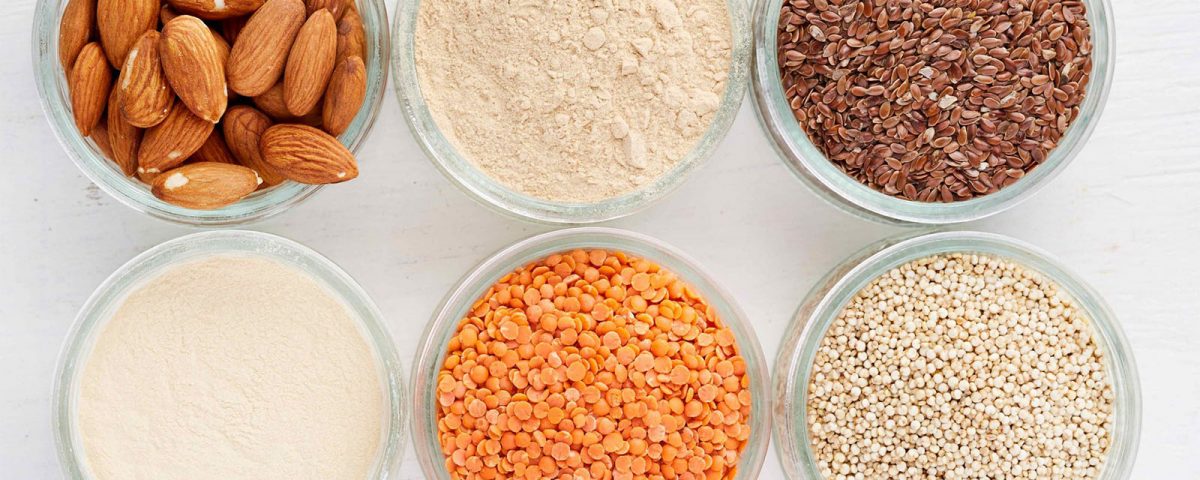
I Eat Grains and I Look Good!
March 2, 2017
Nature’s Candy
March 12, 2017Protein is considered a macronutrient because it is an essential fuel source for our bodies and minds, along with carbohydrates and fats.
Protein is of course needed to build and repair muscles. In addition, protein also creates hormones, maintains the immune system, transports vitamins, and helps with the integrity of our blood, skin, and connective tissue.
Just like calories are not created equal, the same is true of protein. In the Food Target, the most beneficial, most nutritious proteins—those that make your body stronger– will be closer to the center of the target.
Most people associate protein with meat, eggs, and dairy. But, plant-based proteins like nuts, leafy greens, ancient grains, spirulina/chlorella, and legumes can also be a great source of protein; sometimes an even better source. This is because they are not only high in protein, but they also offer a balanced source of vitamins, minerals, and fiber. These plant-based proteins also tend to be easier to digest, which means you are likely to absorb more protein from these sources compared to animal proteins.
From an environmental standpoint, eating plant-based protein is a great deal more efficient for our environment. It takes over 50 grams of grain to make one gram of protein from beef.
Of course there are many benefits to animal products besides just protein. Animal products keep you feeling full and satisfied, contain essential vitamins and minerals, and help with healthy hormonal balance. But, because animal proteins tend to be more acidic than plant-based proteins, they can cause you to become mineral depleted if you eat too much.
To learn more about pH balance and mineral depletion, view video here.
If you are going to consume animal based protein sources, try to move to more organic versions. Conventional animal products tend to contain growth hormones, antibiotics, pesticides, synthetic fertilizers, and genetically modified feed, which can all disrupt our system causing an imbalance of hormones, inflammation, and other health issues. When you buy products with a USDA Organic Seal—you can ensure it will not contain these harmful ingredients. Organic animal products also tend to taste fresher and more flavorful.
Usually when people look to add more protein to their diet they reach for protein powder—specifically whey protein. What is whey exactly? What’s the source of this protein?
Whey protein is the watery portion of milk that separates from the curds when making cheese. Whey is what you get after the fat and casein are removed from milk. Which, means the source is a cow.
The protein molecule in cow’s milk is very different than the protein molecule in human milk and can be very hard for the body to breakdown. This can lead to challenges with digestion and absorption.
The process of making whey protein usually involved high heat or pasteurization like process, which destroys the live enzymes naturally needed to digest this milk-based protein. In addition, whey is very acid forming on the body, which lowers the pH of the normally alkaline environment of the intestinal tract, thus favoring the growth of unfriendly bacteria over beneficial bacteria– all of which can contribute to poor digestion, immune health, and inflammation.
Cutting back on dairy in general is one of the first steps for improving digestion, skin, allergies, and asthma. A better option to cow’s milk is goat’s milk since it has a similar make up to human milk. Did you know that 65% of the world’s population consumes goat’s milk? Goat’s milk is generally easier to digest and absorb due to the small size of its protein molecule, whereas cow’s milk requires up to 2 to 3 hours of digestion and absorption compared to only 20 to 30 minutes for goat’s milk.
If you aren’t a fan of goat’s milk—there are a variety of delicious plant- based milks to choose from like almond, coconut, hemp, oat, and rice milk.
So what are the best sources of protein and how much protein do you really need? See below protein chart for ways you can add more plant-based protein to your diet. Your goal is to consume 15 to 25 percent of your daily calories from high quality protein sources. An easy way to figure out your individual protein needs is take your body weight in pounds and cut it in half. (May be a little less for women)
Remember that protein at the source will usually be less processed, more nutrition, and the least expensive option.
Example: Hempseeds versus Hemp Protein Powder. Hempseeds will be about half the prize of hemp protein powder. Simply add whole hempseeds to your blender or fruit smoothie to make your own version of hemp protein.
Did you know that our Famous Oatmeal On The Run Recipe from Target To Table contains 15 g of protein? Add some hempseeds for an additional 10 grams of protein!
Best Sources of Protein
| Food | Serving | Amount of Protein (g) |
| Organic Chicken Breast | 3 oz. | 26 |
| Organic Lean Beef | 3 oz. | 22 |
| Salmon | 3 oz. | 22 |
| Greek Yogurt (Siggi’s Brand) | 1 cup | 12-15 |
| Lentils | 1 cup | 17 |
| Organic Edamame | 2/3 cup | 10 |
| Hemp Seeds | 3 tbsp. | 10 |
| Pumpkin Seeds | ¼ cup | 9 |
| Rolled Oats | ½ cup | 7 |
| Peanut/Nut Butter | 2 tbsp. | 7 |
| Black Beans | ½ cup | 7 |
| Raw Revolution Bars | 1 bar | 7 |
| Egg | 1 | 6 |
| Avocados | 1 | 6 |
| Quinoa (Complete Protein) | ¼ cup dry | 6 |
| Almonds | ¼ cup | 6 |
| Broccoli | 1 stalk | 5 |
| Tempeh | 1 oz. | 5 |
| Potatoes/Sweet Potatoes | 1 cup (1 medium size) | 4 |
| Brown/Whole Grain Rice | ¼ cup dry | 4 |
| Sprouted Bread | 1 slice | 4 |
| Hummus | ¼ cup | 4 |
| Spirulina/Chlorella | 20 tablets | 3 |
Best Food Groups: Organic poultry, wild caught seafood, nuts, beans, grains
Source of Information: On Target Living : Your Guide To A Life of Balance, Energy, & Vitality








